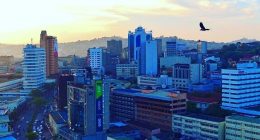If there is a year that changed the course of Uganda’s entertainment industry, it could have been 2008.
That year, under unknown circumstances, a dormitory of girls at Budo Junior School was gutted by fire killing 19 of them. Less out of musical interest than reaction to a national tragedy, many artistes picked interest in the incident and were later to lend their voice to the inferno while appearing in a Bobi Wine music video, Ebibuuzo, which highlighted other disasters that had made news both in Uganda and the world that year.
In the same year, Bobi Wine and Jose Chameleone had enjoyed personal achievements, both of which had changed the face of the art they represented. In a publicised move, Bobi, as he is fondly referred to had entered his plush newly constructed home in Magere, on the northern outskirts of Kampala. With this feat he had overnight become a yardstick of achievement for would be or aspiring artistes, and Bobi Wine would relish the opportunity to use his newly acquired status in his musical battles with fellow artiste Moses Ssali, popularly known as Bebe Cool. On the other hand, Chameleone had wedded his long-time girlfriend Daniela Atim, in yet another highly publicised event.
But the biggest event of the year, was the duo Radio and Weasel consolidating their place on the Ugandan entertainment scene with their first concert at Steak Out, a then popular bar on Lumumba avenue, in the middle of Kampala. The two, Moses Nakintigye Ssekibogo and Douglas Mayanja, alias Radio and Weasel, had been part of artiste Joseph Mayanja alias Jose Chameleone’s Leone Island Crew.
Makindye
The two after parting ways with Leone Island had pitched camp in Makindye, a Kampala Division and one of the city’s administrative zones. With a population of up to 500,000 residents, Makindye like many talent hubs in Uganda, is surrounded by affluent neighbourhoods such as Munyonyo and Bbunga as well as slums in Kansanga, Nsambya, Katwe, Namuwongo as well as Salaama.
Makindye has played a big role in Uganda’s pop culture, gifting the scene with artistes such as Edrisa Musuuza alias Eddy Kenzo, Aziz ‘Azion’ Mukasa, Ibrahim Mayanja alias Big Eye and George William Kigozi also known as Geosteady. But the area has also been home to both audio and video production houses such as Good Enuf, The House of Music, Badi Music, Kann Records and Jah Live.
Makindye according to Ronald Mukalazi, a businessman that runs a bar in the area, became famous among artistes for its many venues that used to host local concerts. “Talent started emerging, especially from the youth that wanted to forge a living, they would show up at bars with the aim of curtain-raising for a bigger artiste.” Mukalazi says that some of that emerging talent failed to make it and some of these would-be artistes found a new calling in music production, to serve the growing music industry in the area and beyond. Studios soon sprang up in the area.

Radio and Weasel had successfully released a hit song that was Nakudata in 2007, but after falling out with their boss, they had moved on to set up Goodlyfe with Chameleone’s former manager Jeff Kiwanuka.
The story is told, the two had visited artiste Omulangira Ssuna and heard him play one of the gospel songs he was yet to release. In less than an hour Radio had written new lyrics for the song that later became Nakudatta.
But it was Radio and Weasel or Goodlyfe they often preferred to be called that benefitted from Nakudatta’s success. In a short time, the duo was at it with Ssuna who was partly claiming their success.
Begin the fights
Such fights would become one of the first things the duo would be synonymous with. At that point their A-list of nemeses featured such big names as Bebe Cool and their former Leone Island boss Jose Chameleone. Henry Ssali, a journalist who was also the owner of the record label UG Records at the time, says artistes such verbally attacks between artistes usually paid off. “Bebe Cool was the kind of artiste that was easy to annoy through a song because he could reply either through a song or during an interview,” noted Henry Ssali while appearing on a radio show.
Yet, while friends with Bebe Cool, Henry Ssali did not think twice about letting his then artiste Rabadaba to join Radio and Weasel on their single Ability, a dig that overtly aimed at Bebe Cool.
“Bebe Cool was the kind of artiste that was easy to annoy through a song because he could reply either through a song or during an interview.”
– Henry Ssali
For the first years of their career as a duo, Radio and Weasel were involved in all manner of verbal fights, most targeting Bebe Cool, Chameleone and their possible associates such as the late Emmanuel Mayanja also known as AK 47, a brother to Weasel and Chameleone.
By this time, such fights among artistes were not new, Bebe Cool, Chameleone and Bobi Wine had been at it for years and much as these feuds had divided their audience, they had in a way also won them a fervent fanbase.
In March 2009, Radio and Weasel were involved in a fight while at Angenoir Discotheque, a hangout place in Kampala. The club’s management reacted by throwing them out of their establishment. However, soon the duo would respond with a song. Much as it is not documented, music pundits believe Kiduula, the duo’s attack towards Angenoir Discotheque, was a first in many ways. Artistes were going after an establishment that many in their industry feared to confront.
The song, Kiduula, Luganda for a noisy village bar described the anarchy in a bar where people enter with all kinds of weapons and intentions. Outside their musical attack on Angenoir, an establishment they believed had wronged them, the duo spared some lyrics in the song for their frenemies in the music industry as well.
Kiduula was a hit in the places it was named after, village bars, but did not get the kind of airplay on mainstream media. Some people have reasoned this could have been to a fact that Angenoir as an establishment was bigger than the artistes and thus, a connection people in the media wanted to maintain.
But the song had sowed seeds of rebellion in many an artiste. Before the year ended Mathias Walukagga, a Kadongo Kamu artiste too had released a single, Bwino W’omutembeyi, taking on Samona, a cosmetic products line, after he had disagreements with the company owner, Mukasa Kasawuli. However, unlike Radio and Weasel, Walukagga’s feud landed the singer in jail for allegations he made against Kasawuli and the source of his wealth.
Making friends in the media
Since Radio and his friend Weasel knew they were waging war with artistes that had been on the industry longer than them, they found the need to have allies outside the music industry, in the media. Isaac Katende, a radio personality that works under the moniker Kasuku says while working for Redpepper, a local tabloid, “it was hard to get close to a celebrity like Chameleone or Bebe Cool.”
These artistes often called editors to send a reporter to cover their shows. “At times they would even deal with some editors to ensure the sent reporter’s story was favourable,” says Kasuku while appearing on a show on one of the leading radio stations in Kampala.
Moses Radio, Weasel and their manager, according to Katende called for a press conference. Flanked by other artistes that were relatively new or obscure, they invited only journalists that were yet to make their mark on the industry.
“I remember Radio and Jeff in that press conference stressing that we were both young and it was time to take charge,” he says.
It was a gamble the duo would extend to their music through a spree of collaborations with then upstarts in the industry like Diamond Oscar, Rabadaba, GNL Zamba, Allan Tonix, Vampino and Viboyo, among others. Some of these names would never see a breakthrough in their musical career but the approach had helped Radio and Weasel to break into the mould of Uganda’s leading artistes that had hitherto been dominated by three local artistes, Bebe Cool, Bobi Wine and Jose Chameleone.
“They broke the sync or yoke of the conventional…that was very powerful. Their music reflects how we live but at the same time embraced globalisation…expression of freedom of people to go out of the conventional approach to life,” song writer Silver Kyagulanyi said of the duo in an interview.
Radio the writer
Yet, towards the end of the first half of the 2010s, Radio had found more ways to collaborate with many of these artistes. He become the most sought-after songwriter.
Radio and Weasel were credited writers for all the songs they produced, with Radio writing a big part of them. Between 2007 and 2009 for instance, the duo had written and released more than 50 songs both for the duo and other artistes.
Among the artistes who would benefit from the duo’s writing talent were Rema Namakula, Julianna Kanyomozi, Lydia Jasmine, Irene Ntale, Fille, Spice Diana and the later on the duo’s doppelganger B2C.
Radio’s writing has been described by various people as cheeky, interesting and yet, very informed. “When you look at his lyrics, they show someone who reads. You would go to his home and find books,” playwright John Ssegawa said of Radio.
Perhaps the duo’s most controversial project, the 2015 campaign song, Tubonga Nawe, meant for President Yoweri Museveni’s fifth term re-election campaign in 2016, split opinion among Goodlyf’s most ardent fans.
Radio had helped compose the song that would feature top local artistes, some of whom he had previously fought, extolling the achievements of the ruling party, NRM, and endorsing the president for re-election.
The outrage from the public was perhaps the beginning of national politics taking a stranglehold on the Ugandan music industry as some artistes took on permanent camps, colours and parties.
It also preceded a foray into elective politics by fellow musician Bobi Wine, with his People Power movement, a move that reignited old rivalry with another artiste Bebe Cool, who had thrown his weight behind president Museveni and the ruling NRM party. The stage of their competition, twenty years on, seemed to move from the music industry into national partisan politics.
Before Radio died on 1 February 2018, the duo had organised two concerts after the Tubonga Nawe controversy. The opinion about the success of the first, dubbed Omwana Wa Bandi, in May 2016 had been divided but a year later, the duo had found the love again for their ten-year anniversary.
The concert, that turned out to be Radio’s last outing, was held at Kyadondo Rugby Grounds on November 3 2017, barely three months before his death.
Postscript
On January 28 2018, Moses Radio who was flanked by friends was involved in a brawl at De Bar, a popular hangout in Entebbe town. In the ensuing exchange, court heard in 2019, the singer was thrown to the ground by Godfrey Wamala and hit his head. He would later succumb to head injuries sustained in the brawl at Case hospital on the morning of February 1 2018.
The prime suspect, Godfrey Wamala, was in October 2019 charged with manslaughter and sentenced to 14 years in jail. Although the trial was initially billed as a dramatic affair, the sentencing passed as a low-key event.
Throughout his career, Radio wrote and released at least 200 songs, on average 20 songs per year in the 10 years the Goodlyf duo were active. Some of his hitherto unheard songs are still being released posthumously, the most popular of which was Tambula Nange,a gospel ballad released weeks before his death.
Radio in Tambula Nange seems to possess a prescience, if not premonition, of his own impending mortality. Yet the song also shows the breadth of imagination and musical dexterity of Moses Radio who so effortlessly transitioned from club bangers, to love ballads, to gospel music, all while retaining a unique sound that so endeared him to millions.
The passing of Radio, one half of Goodlyf, in their heyday dubbed, “East Africa’s dynamic duo,” in many ways brought to an end a decade that had seen the group emerge from the wings of one of Uganda’s greatest music talents, Jose Chameleone, to conquer not only the Ugandan, but regional music scene with their irreverent mix of Luganda, English and Swahili ballads.
Editor’s note: This article was originally published in 2020 under the headline “Radio & Weasel: A Decade in Music”.









